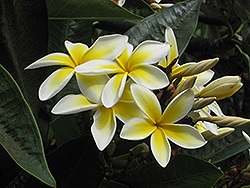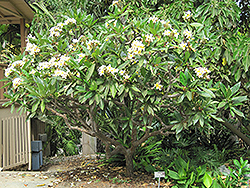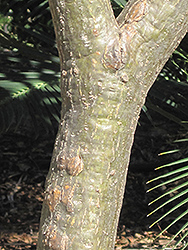Common Frangipani Plumeria rubra var. acutifolia Height: 15 feet Spread: 15 feet
Sunlight:
Hardiness Zone: (annual) Other Names: Nosegay, Temple Tree, Mexican Plumeria Description: A popular shrub or small tree, producing showy white flower clusters over deep green contrasting foliage ; often used as a patio plant; pruning required to maintain strong structure; parts of this plant are known to be toxic Ornamental Features Common Frangipani features showy clusters of fragrant white trumpet-shaped flowers with yellow throats at the ends of the branches from mid summer to mid fall. Its pointy leaves remain dark green in color with curious light green undersides throughout the season. Landscape Attributes Common Frangipani is a multi-stemmed annual with an upright spreading habit of growth. Its relatively coarse texture can be used to stand it apart from other garden plants with finer foliage. This plant will require occasional maintenance and upkeep, and should only be pruned after flowering to avoid removing any of the current season's flowers. Deer don't particularly care for this plant and will usually leave it alone in favor of tastier treats. Gardeners should be aware of the following characteristic(s) that may warrant special consideration;
Common Frangipani is recommended for the following landscape applications;
Planting & Growing Common Frangipani will grow to be about 15 feet tall at maturity, with a spread of 15 feet. It tends to be leggy, with a typical clearance of 2 feet from the ground, and should be underplanted with lower-growing perennials. Although it's not a true annual, this plant can be expected to behave as an annual in our climate if left outdoors over the winter, usually needing replacement the following year. As such, gardeners should take into consideration that it will perform differently than it would in its native habitat. This plant does best in full sun to partial shade. It is very adaptable to both dry and moist locations, and should do just fine under typical garden conditions. It is considered to be drought-tolerant, and thus makes an ideal choice for a low-water garden or xeriscape application. It is not particular as to soil pH, but grows best in sandy soils, and is able to handle environmental salt. It is highly tolerant of urban pollution and will even thrive in inner city environments. This species is not originally from North America, and parts of it are known to be toxic to humans and animals, so care should be exercised in planting it around children and pets. It can be propagated by cuttings. Common Frangipani is a fine choice for the garden, but it is also a good selection for planting in outdoor pots and containers. Its large size and upright habit of growth lend it for use as a solitary accent, or in a composition surrounded by smaller plants around the base and those that spill over the edges. It is even sizeable enough that it can be grown alone in a suitable container. Note that when growing plants in outdoor containers and baskets, they may require more frequent waterings than they would in the yard or garden. Characteristics
Applications
Features & Attributes
|


